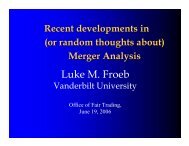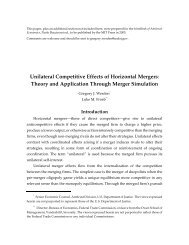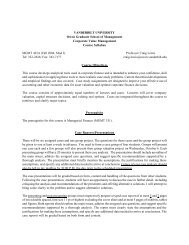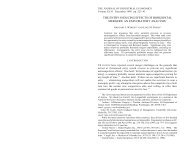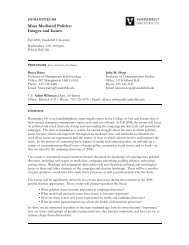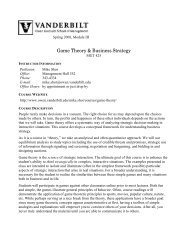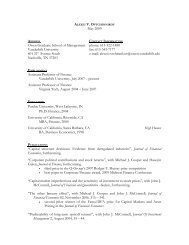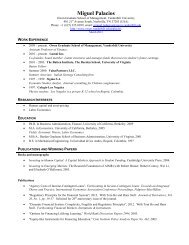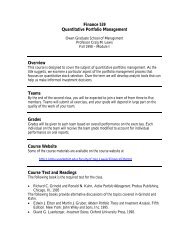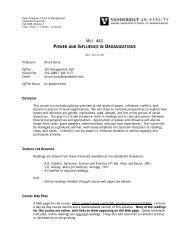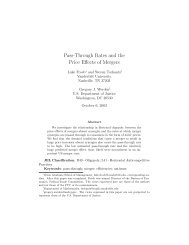Whither Merger Simulation? - Vanderbilt Business School - The ...
Whither Merger Simulation? - Vanderbilt Business School - The ...
Whither Merger Simulation? - Vanderbilt Business School - The ...
You also want an ePaper? Increase the reach of your titles
YUMPU automatically turns print PDFs into web optimized ePapers that Google loves.
theantitrustsource www.antitrustsource.com May 2004 1<strong>Whither</strong> <strong>Merger</strong> <strong>Simulation</strong>?An ABA Section of Antitrust Law “Brown Bag” Program Held January 29, 2004MODERATORPARTICIPANTSMichael S. BeckerLuke FroebDavid T. ScheffmanGregory J. WerdenPartner, Kirkland & EllisDirector, FTC BureauDirector, LECG,Senior Economic Counsel,of EconomicsAdjunct Professor,Antitrust Division,Owen <strong>School</strong> ofU.S. DepartmentManagement, andof JusticeFormer Director,FTC Bureau ofEconomicsEditor’s Note: <strong>The</strong> beginning of Dave Scheffman’s second incarnation as the Economics Bureau Director at the FTC might beregarded by some as a “reign of terror” when the topic was the utility of Bertrand simulations for unilateral effects analysis.Indeed, Scheffman seemed to almost single-handedly bring coordinated effects (warts and all) back into the merger analysis limelightas he “dissed” unilateral effects.A recent ABA brown bag on merger simulations included Luke Froeb, the current Bureau of Economics Director, and GregWerden from the Antitrust Division—both of whom are particularly well-versed in the estimation and use of simulation models—as well as Scheffman. For those who wonder how the DOJ and the FTC view simulations as a methodology for evaluating mergersand for those who might wonder whether time has mellowed Scheffman’s views, cruising through the transcript—an easy read—should be helpful. I, for one, did not see any mellowing.A few samples of the discussion follow. All three speakers agree that there is no real evidence—or maybe just no evidence—thatBertrand simulations are reasonable predictors of the post-merger effects. Werden and Froeb, however, conclude that if the simulationcan predict the present (and its assumptions are, at least in a stylized way, consistent with what we know about the particularindustry), it can in fact be used as a tool in merger analysis. While Scheffman seemingly agreed with that conclusion, the inability(in his view) of the model to take into account important competitive variables (such as non-price competition) certainlysuggests that the Bertrand simulation is a tool worth leaving to rust in the tool box.All three presenters seemed to agree that the Bertrand’s focus on price-effects alone is not a sufficient analysis. All agreed thatthe economist evaluating merger effects must also consider repositioning, entry, and retail-wholesale relationships, and other factors.But (in my read) where Werden and Froeb would use these facts along with the (correctly calibrated) simulation in a complete
theantitrustsource www.antitrustsource.com May 2004 2evaluation of the merger’s effects, Scheffman seemed to believe that the Bertrand model is so far removed from a model of competitionthat the use of the Bertrand simulation in merger analysis should have a weight close to zero.Scheffman also opined that one substantial cost of using the simulations in merger analysis is that analysts (lawyers, and maybeeven some economists) have supported or opposed a merger based on vague factual (or maybe, metaphysical) views on the closenessof the products of the merging parties, what Scheffman calls “squishy” facts. But Werden and Froeb are clear that for economists,all of the assumptions of the model must be vetted against the facts and the model’s sensitivity to those assumptions testedbefore it can be usefully employed in merger analysis.My take on this debate is straightforward. <strong>The</strong> general view that in the context of unilateral effects, the simulation model properlyused can be a helpful and insightful tool in merger analysis seems unobjectionable. A simulation model that can capture theessence of price competition in an industry and predicts a non-trivial post-merger price increase tells us something about the burdenthat must be carried by other arguments—entry, repositioning, advertising, innovation, capacity constraints, etc.—if the mergeris to be cleared. Scheffman is surely right that simulations are not a substitute for thinking. But simulations thoughtfully usedcan be the beginning of a careful and focused merger analysis.—JOHN R. WOODBURYMICHAEL BECKER: <strong>The</strong> topic today is merger simulation. I think today’s presentation can provide uswith an overview of the pros and cons of merger simulation and help enlighten us on where theagencies think the current state of the art is. We have three speakers today. <strong>The</strong> first two speakersare Greg Werden and Luke Froeb. Greg is Senior Economic Counsel at the Antitrust Divisionat DOJ and Luke is the Director of the Bureau of Economics at the FTC. Both Greg and Luke havewritten on merger simulations. I think it’s fair to say they are viewed as proponents of simulation,and they’ll be discussing some of the pros of merger simulation and some of the misuse too. <strong>The</strong>final speaker will be David Scheffman, who is Luke’s predecessor at the FTC and is now with<strong>Vanderbilt</strong> University and LECG. David’s role today is to play the critic of merger simulation.GREG WERDEN: <strong>Merger</strong> simulation uses standard tools of economics to predict the unilateral competitiveeffects of proposed mergers. An oligopoly model is selected that reasonably reflects thenature of competition in the industry, and the model is calibrated using prices, market shares, andother observable quantities. <strong>The</strong> calibrated model is then used to compute the post-merger pricesand shares that internalize competition among merging products.Although merger simulation can be applied to many types of industries, the main applicationis with branded consumer products. In that application, all of the attributes of the products areheld constant, and competition is strictly on the basis of price. A lot of other assumptions are conventionallymade, including that marginal costs are constant and, in most applications, that retailerstake constant percentage markups over wholesale prices.<strong>The</strong> calibration of such a merger simulation is designed to make the model perfectly predictsome “but for” world. That usually is the actual world observed before the merger, but it can besomething else if the future is likely to differ significantly from the past, absent the merger. Calibrationinvolves prices, shares, and demand elasticities. <strong>The</strong> prices and shares don’t raise many issues, butthe elasticities can cause a lot of problems. I’m not going to talk about estimation at all today, butthere are a host of issues in the estimation of demand elasticities that can be very challenging.
theantitrustsource www.antitrustsource.com May 2004 3My basic thesis is thatmerger simulationshould be disciplined,whether in thecourtroom or outside,by the Federal Rule ofEvidence 702 and theDaubert decision andits progeny . . .—WERDEN<strong>The</strong> advantages of the merger simulation are, first, it provides quantitative predictions of theunilateral price effects of mergers. It’s not the only way to do that, but I think it’s the main way. It’salso easy in a merger simulation to take account of marginal cost reductions from merger synergiesand compute net effects on price. Finally, merger simulation can be a great tool for focusingan investigation by identifying critical facts: what things matter, what things don’t, how things matter,and how much they matter. By facilitating the identification of vulnerabilities, merger simulationhelps indicate how best to allocate the investigative resources.Of course, there are serious limitations. One important limitation is that a conventional mergersimulation requires an assumption about functional form for the demand curve, and the predictionsare fairly sensitive to that assumption. My advice on that is to make the assumption that’s theleast advantageous to whatever side you’re working for. <strong>Merger</strong> simulation does not, as it’s generallypracticed, allow the investigation of prospects for entry or product repositioning; they areassumed away. And it’s perfectly possible that firms in the real world do not play the same strategiesthat they do in the model, so it’s not necessarily the case that merger simulation tells youwhat’s actually going to happen after a merger.<strong>The</strong>re are several things I call “non-fatal flaws” in merger simulation. <strong>The</strong>se are problems I don’tworry much about. One is that the models available for use in merger simulation cannot possiblycapture every nuance of competition in the real world. But that really isn’t necessary. Capturingenough makes the predictions good enough. Models are never going to be perfect, and that isnot the goal. <strong>The</strong> price increase predictions are at best rough estimates, but rough estimates arebetter than no estimates.Finally, merger simulation cannot predict the long-run evolution of an industry. It cannot saymuch about entry or product repositioning; it cannot say much about changes in marketing strategy.It indicates only relatively short-term effects: how prices will be adjusted by the merging firmsafter the merger, and how the non-merging firms will respond to those price changes.<strong>The</strong>re are also potentially fatal flaws in merger simulation. First, an improperly calibrated mergersimulation doesn’t predict the merger-induced price changes. While I think it’s fairly trivial to calibratea merger simulation properly, I have seen that not done. I don’t mean done improperly, butrather not at all, which produces nonsensical comparisons between the predicted post-mergerprices and the pre-merger prices. Secondly, doing a merger simulation requires a well-specifiedeconomic model of oligopoly, and the available models don’t fit all the industries. Sometimes theydon’t fit very well at all. <strong>The</strong>y may not explain how manufacturers compete; they may not explainhow retailing works; and they may not explain the relations between manufacturers and retailers.If they are far enough off, the predictions may be useless, and the models should not be used.In a merger simulation, the general practice is to start from prices, shares, and demand elasticities,and work backwards to what the marginal costs would have had to have been if thoseprices, shares, and demand elasticities were an equilibrium before the merger. This infers the marginalcosts, and provides a set of inferred marginal costs that can be compared to whatever evidencethere may be on actual marginal costs. This comparison is important. It indicates whetherthe model jibes with the real world in terms of the general level of intensity of competition. It’s notuncommon that some of the inferred marginal costs are very implausible, and something has tobe done about that. <strong>The</strong> something may be abandoning the whole project, but usually there areless drastic and more useful things to do.<strong>The</strong> foregoing is all introduction. My basic thesis is that merger simulation should be disciplined,whether in the courtroom or outside, by the Federal Rule of Evidence 702 and the Daubertdecision (Daubert v. Merrell Dow Pharmaceuticals, Inc., 509 U.S. 579 (1993)) and its progeny,
theantitrustsource www.antitrustsource.com May 2004 4which limit the courtroom admissibility of expert testimony in ways that I think the analysis doneoutside of court similarly should be limited. Translating Rule 702 into principles for economic testimony,there are basically three conditions for admissibility of expert economic testimony: First,the witness has to be an expert in the relevant field of economics, and I emphasize relevant field.Being an economist, even a Ph.D. economist, is not nearly enough, and the case law is startingto recognize that. Second, the testimony has to employ sound methods from the relevant field ofeconomics. Under the Federal Rules of Evidence, whatever methods economics considers soundmay be used in court. Finally, the testimony has to apply those methods reliably to the facts of thecase, and that’s really the most important thing. <strong>Merger</strong> simulation should be based on the facts.My slides go through some case law precedent and offer some arguments based on this precedent.[Ed. Note: Slides are available at http://www.ftc.gov/speeches/other/040129werden.pdf]I won’t go through them in detail, but there are a couple of interesting points I’ll mention. Someantitrust cases have excluded economic testimony because the witness was not considered anexpert. <strong>The</strong> one I find most interesting excluded testimony on the relevant market from a Ph.D.economist who had “no background in antitrust markets.” (Nelson v. Monroe Regional MedicalCenter, 925 F.2d 1555, 1572 (7th Cir. 1991)) He was a health care economist, and it was a healthcare case, so it made some sense to use him as a witness. But in a concurring opinion, one judgein the Seventh Circuit found that he had no business testifying about relevant markets because hedidn’t know anything about the analysis of relevant markets. I think there will be a lot more decisionsin which Ph.D. economists are not allowed to testify about certain antitrust issues becausethey don’t know anything about those issues. I certainly hope we get decisions like that.In my view, merger simulation testimony should be excluded if the witness doesn’t have someexperience doing merger simulation. A quote from physicist Werner Heisenberg captures well theissue here: “An expert is someone who knows some of the worst mistakes that can be made in hissubject and who manages to avoid them.” Luke and I learned through trial and error how to avoiddoing merger simulations badly. <strong>The</strong> only way I know how to learn to do anything is to do it, andexperience teaches what not to do.Economic testimony has been excluded in antitrust cases for failure to meet professional standardsin economics. Most such testimony was empirical analysis, but the same rationale wouldapply to merger simulation. As to whether merger simulation is a sound method, in a sense, theanswer is simply “yes.” <strong>Merger</strong> simulation uses sound methods from economics—standard oligopolymodels. If estimation is done, it uses standard econometric techniques. All of that is theoreticallysound. What we cannot say is that merger simulation is empirically sound; we cannot saythat merger simulation accurately predicts the actual effects of mergers. We don’t know. On theother hand, there is no evidence that any method accurately predicts the actual effects of mergers,so simulation is on par with other methods of analysis in that regard.Daubert and progeny have taught us that economists have to go into court with the tools of economics.While the lawyers can get away with invoking presumptions based on market shares andcase law precedent, expert witnesses cannot; they must have something else. <strong>Merger</strong> simulationisn’t the only something else, but it’s one possibility.In the slides, I quote dicta from Daubert and General Electric Co. v. Joiner on the issue of fit.One of my favorite quotes, which I use quite a lot, is that a court should not “admit expert opinionthat is connected to the existing data only by the ipse dixit of the expert.” (General Electric Co. v.Joiner, 522 U.S. 136, 146 (1997)) Traditionally, I think a lot of expert testimony was connected tothe existing data only by the ipse dixit of the expert, and one should be alert for that possibility.
theantitrustsource www.antitrustsource.com May 2004 5My bottom line is thatevery modeling choice,and there are a lotof them, has to bejustified in some way.<strong>The</strong> justification can bethat economic theorydictates that particularchoice. For example,I think the onlyjustification needed forthe profit maximizationassumption is thatthat’s what economistsassume.—WERDENWithout a strong connection to the facts, the analysis ought not to be admitted in court or doneout of court. Quite a few decisions have excluded expert economic testimony for ignoring importantfacts. Some of these involved empirical analyses, and some of them did not. My slides giveexamples that are fairly well known from the Brand Name Prescription Drugs Antitrust Litigation,as well as a couple that aren’t quite so well known.One particularly interesting case, which I’m sure you’ve all heard about, is Concord Boat, inwhich the testimony of Robert Hall was excluded and a substantial damage award vacatedbecause his oligopoly model was “not grounded in the economic realities of the industry.”(Concord Boat Corp. v. Brunswick Corp., 207 F.3d 1039, 1056 (8th Cir. 2000)) What the EighthCircuit did in that case is exactly what courts should do when confronted with merger simulation.<strong>The</strong> court looked at what Hall did and found it just didn’t match up with the real world. His modelwas a perfectly fine model, but just not the right model for that industry. And the way he calibratedthe model, to use merger simulation terminology, did not make sense. His model said thedefendant’s market share wouldn’t be more than 50 percent without engaging in the challengedpractices, but the defendant’s share was 75 percent before it engaged in any of the challengedpractices. <strong>The</strong> court didn’t think that made any sense, and neither do I, and a lot of moneychanged hands because it didn’t make any sense.A less well-known case, but one that has a very nice statement of what was wrong with theexpert’s analysis (or could have been wrong, since I don’t know if it really was wrong) is theBooksellers case. Frank Fisher’s testimony on how to reckon damages was excluded because itcontained “too many assumptions and simplifications which are not supported by real world evidence.”(American Booksellers Ass’n, Inc. v. Barnes & Noble, Inc., 135 F. Supp. 2d 1031, 1041(N.D. Cal. 2001)) Doing any kind of economic modeling requires making assumptions and simplifications.<strong>The</strong> court was looking for evidence that the assumptions made sense, and it didn’tthink it had enough such evidence. I have no idea what evidence it had, but I find heartening thatit was asking the right question.Of course, a perfect fit is not required; in fact, it’s not even desirable. Trying to make the modelfit all the facts makes it too complicated and no longer a useful model. It’s not going to predict. Inselecting a model, the totality of the evidence should be examined to see what can be learnedabout how competition works. If there is such a model, a model should be selected that fits theresulting understanding of how competition works. Of course, different people may look at thesefacts and come away with different views about how competition works. That’s okay. Daubert’srequirement of intellectual rigor doesn’t mean that there’s only one right analysis.My bottom line is that every modeling choice, and there are a lot of them, has to be justified insome way. <strong>The</strong> justification can be that economic theory dictates that particular choice. For example,I think the only justification needed for the profit maximization assumption is that that’s whateconomists assume. A choice can be supported by industry data; for example, observed pricesand shares are used to calibrate a model. Assumptions also can be consistent with stylized facts.If the industry sells differentiated products, it shouldn’t be hard to muster facts that buyers andsellers perceive the product as differentiated—that brands matter. Or, an assumption can beunimportant. It may be fairly easy to show that nothing much changes from tweaking a particularassumption a little. If that is so, no further justification is required.Finally, absent any of the foregoing, some kind of sensitivity analysis is required to show howthe predictions depend on the assumptions. Some assumptions are very important: Changingthem changes the predictions substantially. With such assumptions, it is best to take a conservativecourse. Testifying for the government, I would always go with the low range of price increase
theantitrustsource www.antitrustsource.com May 2004 6predictions, depending on different assumptions like demand functional form, ranges of elasticities,and things like that.Any sort of economic analysis, and we’re talking about merger simulation today, has to bebased on something, largely the facts, and Luke and Dave are going to basically continue withthat theme.I think the discipline ofmodeling, and the linkthat it exposes betweenthe evidence in a caseand the conclusionsdrawn, are its mainvirtue. A model forcesthe economists to“put their cards onthe table.”—FROEBLUKE FROEB: We’ve been doing merger simulations for at least a decade, and we’ve learned a lotof things by trying to actually model mergers and fit models to the facts of the industry. <strong>The</strong>re area lot of surprising things, perhaps the most basic of which is that the merger effects are so small.When we started out doing this, we had some very big mergers, and it just was inconceivable thatwe were getting such miniscule effects, given the elasticities and all the assumptions that we hadmade. We’ve fit models to industries that are capacity constrained, and we’ve learned that capacityconstraints on the merging firms matter a lot more than the capacity constraints on the nonmergingfirms. Capacity constraints on the merging firms attenuate the merger effect by muchmore than capacity constraints on the non-merging firms amplify them.I think the discipline of modeling, and the link that it exposes between the evidence in a caseand the conclusions drawn, are its main virtue. A model forces the economists to “put their cardson the table.” Attorneys can then challenge a model by challenging the evidence that feeds intoit, or they can challenge the link between the evidence and the conclusion. A model should beused to interpret the evidence, not to substitute for evidence in a case. That’s my basic outline,and I’m going to illustrate some of the principles that Greg has discussed. [Ed. Note: Slides areavailable at http://www.ftc.gov/speeches/other/040129froeb.pdf.]Let me just start out with some definitions. <strong>The</strong> “back end” is the use of a structural model,meaning we actually have models about how firms, consumers, and retailers behave, and wehave an equilibrium notion about how they all interact and what happens. <strong>The</strong> “front end” involvesthe parameters that feed into the models, which come from evidence or estimation. Pre-merger,we observe an equilibrium and post-merger, we’re predicting an equilibrium.Antitrust, or certainly the model side of antitrust, hasn’t been in the prediction business for verylong, and we can learn from our sister field of macroeconomics. Macroeconomists had writtendown all these models to describe what they could observe, and somebody got the bright ideaof using the models to forecast what we can’t observe. When they started forecasting out of sample,they found out that they really couldn’t predict as well as they thought they could. <strong>The</strong> ClaytonAct put us into the prediction business, so what we’d like is evidence on the accuracy of out-ofsampleforecasts, but for a lot of reasons, we’re not going to get much. It’s difficult to estimate theeffects of mergers after the fact, and even if you do estimate the effects of a merger, it’s very difficultto go back and actually run a simulation using evidence that would have been available onlyat the time of the merger. So, for a variety of reasons, we’re not likely to get good evidence on outof-sampleforecasting accuracy. What are we then left with? How do we evaluate the reliability ofthese models?What Greg is proposing is that if a model does not accurately predict what we can observe, weought to be very suspect about using the model to forecast what we can’t observe. If you can’t predictthe present, you shouldn’t use the model to forecast the future. Having said that, the three ofus don’t completely agree on how well the model should be able to predict what is observed, e.g.,what facts are relevant, to determine whether a model is reliable or not.Much of the criticism of structural modeling comes from attorneys who worry both about thecosts of merger simulation—estimating the parameters of the models can be a long and costly
theantitrustsource www.antitrustsource.com May 2004 7<strong>The</strong> crucial question is,are we simplifying toomuch? Do the modelsabstract away fromcrucial pieces ofbehavior, of reality?—FROEBundertaking—and about the way they can focus an investigation on evidence that is unlikely toinform the fundamental questions raised by the case. For example, attorneys who have used modelinghave run up large bills only to see the estimates as being wacky or not consistent with theirprior beliefs. So merger simulation has gotten a bit of a black eye. <strong>The</strong> pro estimation side of thedebate would be to say: Data are the only source of knowledge; the way to interpret data is econometrics;and any problems we run into we have satisfactory solutions. <strong>The</strong> con side is: <strong>The</strong> datajust doesn’t speak to the policy question that we’re trying to answer; a lot of problems don’t havesatisfactory solutions; and it’s a very costly proposition.Where do I come away on the estimation debate? This is going to annoy you as I’m sure itannoys my students at <strong>Vanderbilt</strong> when I tell them, the answer is, “it depends.” I always wait untilthey’ve paid their tuition before I tell them that, but it does depend on what you’re trying to do, andmerger simulation should not be used as a black box that applies in every case. It’s a tool, andyou can only judge the utility of a tool by the use to which you put it. It’s appropriate for some jobs,but not for others.Is simulation likely to convince the key decision makers? Again, it depends. It depends on howwell the model describes the evidence. Is it likely to reduce uncertainty? Before you engage in along estimation exercise, ask the economists what would we get if we didn’t have to estimate thedemand, what if we knew exactly what the model was going to predict, what would we be able tosay? Would that convince anybody? If you estimate an outcome that favors your client, would thatconvince anybody that you weren’t just fishing for that outcome? So put your economists to thetest, ask them some questions. We’re going to give you some questions to ask them.Is simulation necessary for defensive reasons? Critiquing methodology is really hard withoutfirst replicating it. Does some number beat no number? I think that’s certainly true in a damageestimation, and these models are used in damage estimation. In a case I worked on shortlybefore coming to the FTC, we successfully defended a damages case without putting out our ownnumber, but it was difficult. Without a model, you have to argue that their model is not any goodat all; whereas if you put up your own model, your burden is lower as all you have to do is arguethat your model is better than their model.One of the reasons we started doing simulations is that, in the late eighties, the Department ofJustice got away from coordinated effects stories for a lot of reasons. We weren’t bringing mergercases in the kinds of industries where we saw collusion. We were bringing cases in the kindsof industries where we didn’t see collusion, and the stories evolved into unilateral effects storiesthat fit the facts of those cases much better. <strong>The</strong> basic unilateral effects story is that, pre-merger,the merging firms price independently, and post-merger they take account of cannibalization,which changes their profit calculus. That changes the equilibrium, and the merged firms raise theirprices, and the non-merging firms raise their price sympathetically. This makes it seem like theonly issue is how much, but behind the unilateral effects story is a very complex structural gametheoretic model built on assumptions about how firms, retailers, and consumers behave.How do we know when these models give reliable forecasts? Well, we don’t know. <strong>The</strong> ultimateproof is prediction. <strong>The</strong>re’s been very little out-of-sample prediction with these models. We’re seeingmore of this. We’re trying to do some of that at the FTC, but it’s very difficult to do. In theabsence of evidence of good out-of-sample predictions, I think we go back to the Daubert disciplineand ask how well these can models describe what we can observe.I’m going to illustrate how to bring the Daubert discipline to the modeling choices. <strong>The</strong> crucialquestion is, are we simplifying too much? Do the models abstract away from crucial pieces ofbehavior, of reality? What we three have come up with is a rule saying: If an assumption matters
theantitrustsource www.antitrustsource.com May 2004 8to the model and matters to how you interpret the results of the model, then the assumption eitherought to be supported by evidence or, if you don’t have good evidence, you ought to do sensitivityanalysis to give the decision makers some idea of how sensitive the model is to the assumptions.Let me give you some examples.One of the things that we commonly do when we use merger simulation is to ignore the retailsector, or assume it just marks up the wholesale price and passes on whatever upstream mergereffect there is. That story could be right, but if it isn’t right, merger effects can disappear. If aretailer and a manufacturer jointly maximize the profit pie between them, there’s one price thatmaximizes the profit pie, and that price is not going to change post-merger. That’s a second story.<strong>The</strong> split of the profit pie might change, but the retail price does not. So if that’s how the retailersare behaving, there is no merger effect. <strong>The</strong>n a third story is that there’s double marginalization,and that can either amplify or attenuate merger effects. This assumption really matters. You haveto gather evidence on it. One thing you might do is try to look at retail margins and wholesale marginsand see if you can distinguish among these three stories.Another thing that matters is demand curvature. I’ve plotted four demand curves between thecommon competitive equilibrium and the four different monopoly equilibria. <strong>The</strong>se four demandcurves all share the same competitive point, which is a quantity of ten and a price of four. Whenwe extrapolate to the post-merger equilibrium, we get dramatically different results. If you had onlydata at the pre-merger equilibrium, how could you distinguish between those four demandcurves? <strong>The</strong>re’s no way to do it. So here’s an assumption that matters a lot. You get three timesthe merger effect if you use a constant elasticity demand curve than if you use a linear demandcurve. If you don’t have any evidence, and you won’t, you have to do a sensitivity analysis andmake a conservative assumption. If you’re the plaintiff, assume linear or logit demand. If you’re thedefendant, assume a constant elasticity or an AIDS demand.Demand elasticities matter a lot in these models. <strong>The</strong>y’re difficult to estimate precisely. If youuse a strict classical confidence interval, assuming you could compute one—and that’s not a trivialexercise—often the uncertainty is so large that both the pro- and anticompetitive scenarios arein that confidence interval. One of the things you can do is a sensitivity analysis, and here I’vetaken data from the WorldCom-Sprint merger that was challenged by the DOJ and then abandoned.I’ve used a logit demand model calibrated to the WorldCom demand elasticity. Thisdemand curve depends on only two parameters, which reflects an assumption about what thecross elasticities look like. Given this assumption, the merger effects don’t depend that much onthe elasticities. You get from a half a percent to about a 1.25 percent industry price rise followingthis merger, and these are relatively easily offset by small efficiencies.Be careful about hiring academics, and I say this as an academic. Don’t trust us. We are interestedin methodological innovation, while practitioners want to know how well does a methodologyfit the facts of the case, and I think that’s the crucial concern. <strong>The</strong> conclusion of every academicarticle is, “it depends,” and you show the tradeoffs in some kind of elegant way, and youget published in a journal that nobody reads. A practitioner wants an answer, and it’s very difficultto get an academic to come down on one side or the other. As academics, you get peer review.I’ve got five of these sitting on my desk, and I’m probably going to devote a little bit of time to eachone of them. But if you use one of these models in a damage case, you’ll get a $100,000 refereereport. In many ways, I think that the legal standard is higher. <strong>The</strong> analysis you come up with hasgot to be practicable and it’s got to fit the facts of the case.My final flag is probably going to go over the heads of anybody who hasn’t read Das Kapital,but I’m trying to put this in a larger framework. What are we trying to do here? We’re trying to push
theantitrustsource www.antitrustsource.com May 2004 9economics forward, make it more relevant and more useful to practitioners. Greg and I are older,wiser, and much more cautious than we were ten years ago. Dave has been a very useful critic ofours, forcing us to reexamine everything we thought was true, and hopefully we’ll come up with asynthesis. Modelers must pay attention to the details of the industry—you can’t just assume a canopener—you’ve got to make it fit the facts of the case. A lot of times we’re dealing with complexsituations that are simply beyond our capabilities or we have an alternate, simpler, empiricalreduced-form methodology—natural experiments—that we can exploit to draw inferences aboutthe effects of the merger.One of the things that the Chairman asked me to do when I came here is follow up on theenforcement R&D started by my predecessor by actually trying to do some of the merger retrospectivesand provide evidence on out-of-sample forecasting that’s necessary to validate thesethings, and finally to come up with more realistic or better models to do merger analysis. I expectthat this effort will help us better identify those situations where simulations work.DAVID SCHEFFMAN: This will be part love him and—given that Greg and I are here—well, knowingGreg, I don’t know what the other part will be. I’ve been very critical of simulations, publicly, andI’m going to say some things that are somewhat critical today. Let me say I have the highest regardfor Luke and Greg. I’ll say, and I don’t give compliments easily, I don’t think anyone’s contributedmore to antitrust economics over the last twenty plus years than Greg. He’s very careful, very thorough,and his contributions have all been very important, both to economics and to policy andparticularly how we analyze mergers. Luke is a first rate applied econometrician and industrialorganization economist and the two of them together have made a lot of contributions, one ofwhich is merger simulations.I won’t talk about how old I am and where my perspective comes from. I am an economist,which some of you don’t believe. I do believe in models and modeling, that models and modelingcan be useful and, yes, models simplify things but they necessarily have to. My colleagueswho I argued with often when I was back at the FTC when I made all these pronouncements aboutmerger simulations, it’s not so much that they were wedded to merger simulations but that theydeveloped the view that I was criticizing economics, and they always made the point, as I havein that last paragraph there on that slide, which is absolutely right. [Ed. Note: Slides are availableat http://www.ftc.gov/speeches/other/040129scheffman.pdf] <strong>The</strong>y say, but wait a minute, lookwhat’s on the other side. Look what the lawyers are doing. <strong>The</strong>y have some sort of model, whoknows what it is, that leads to their recommendations on a merger case. At least we have someeconomic methodology, we’re up front about our assumptions, and that’s better than the alternative,and as an economist, I’m inclined to be sympathetic to that view.I think one thing that happened with the rise of unilateral effects analysis was that it was a dangeroustool for lawyers. <strong>Simulation</strong>s weren’t the problem because simulations actually didn’t havemuch effect one way or the other, at least in the U.S. And simulations may turn out to be beneficialas we learn more. <strong>The</strong> problem is that, from the point of view of how the agency lawyers wouldlook at unilateral effects—as I’ve often said, we went back to the 1960s style of merger analysis—lawyers concluding that two companies compete with one another and on the basis of often verysquishy arguments, concluding that they compete particularly closely with one another. So, voilà,we have a unilateral effects theory. That’s just not right as a matter of law and it’s certainly not rightas a matter of economics, and so we have a problem. I’m not criticizing the lawyers at the FTC—both agencies are absolutely superb at what they do—and they’re very good at basic economics.But the problem we have here is a gap between very formal models that the economists use
theantitrustsource www.antitrustsource.com May 2004 10My concern is that, aswe all know, we don’tusually use models inmost merger analyses.Most matters are toocomplicated.—SCHEFFMANand what we more often do: We apply economics in a very squishy situation but hopefully withsome economic discipline. That requires you to be very sophisticated as an economist or that yoube a lawyer who’s pretty good in basic economics but doesn’t have the background or sophisticationto do simulations.So what do I like about simulation? I like Greg’s and Luke’s paper in the Swedish volume,I think—the general argument about why simulations are a good idea. That is, you should try insome disciplined way to put all the factual information together—cost, demand, what you knowabout competition and other sorts of things—to try and reach a sound conclusion. Very often inthe agencies and on the outside, things get pretty squishy and you say, well it’s anticompetitivebased on a lot of relatively squishy stuff, which might be right. I think what economists can do istry and put all that evidence together and come up with a conclusion, nothing anywhere near asprecise as a Bertrand simulation model, but that at least provides something economists canargue about as to what assumptions, what facts are important as to whether we really thought theprice increase was going to be 10 percent or 1 percent and why, etc.So I like that paper a lot, I like the work that both Luke and Greg have done. It’s been recognizedacademically, helped Luke get tenure at a first-rate university, and rightfully so, but I thinkit’s just the beginning. It’s a very promising beginning. But we have much more work to do.Enough lovefest. Let me talk about my concerns. My concern is that, as we all know, we don’tusually use models in most merger analyses. Most matters are too complicated. Fortunately, inindustrial mergers, we can rely a lot on customer opinions and other sorts of things. In bidding situations,we can use models and, in my view, those are probably the situations where models aremost useful. But on average, in the agencies we economists don’t use models. We often do noteven have the data really to do much modeling.But, when we say “differentiated products” and we have some data at the consumer level,voilà!—all of a sudden we can model because we have a 150-year-old model—Bertrand—and wehave some data two or more levels down. I’m not saying that’s not a potentially useful exercise butit requires some thought.Now here’s where the “non-economist,” or as I would rather put it, the “augmented economist”side of me comes in. I have been a strategy and marketing professor now for fifteen years at apretty good business school, and clearly Bertrand does not at all replicate the way competitionreally works. It does not have anything very important to say about how competition occurs inbranded products mergers. That’s because, as I’ll discuss in a minute, Bertrand is not really amodel of competition.So my concern is that we have something which is actually very complicated to explain, reallymuch more complicated than our typical industrial products merger because we have branding,we have retailers, we have consumers, we have all sort of complexities, complex relationshipsbetween retailers and manufacturers and we say, voilà!—because it’s differentiated products wecan explain it with a simple model. I’m very skeptical of that.Nonetheless, I would not say that that can’t be true, and that’s because even though it clearlydoes not at all replicate real behavior in consumer products markets, it may be a useful metaphorfor explaining equilibrium. That’s what I understand to be the “Willig justification”—what I ascribedto Bobby, but probably came from Greg. <strong>The</strong> Willig justification for unilateral effects says if youthink about Bertrand, all that’s really going on in Bertrand is internalizing the cannibalization thatoccurs between the competing brands, and that might provide a post-merger incentive to raiseprice. What you could say, perhaps, is that in any sort of model where cannibalization considerationsare going to be important, Willig is probably right.
theantitrustsource www.antitrustsource.com May 2004 11For lots of reasons,I’m absolutely convincedBertrand is notthe right model. But asI discussed earlier,it might be, it could beright as a model toexplain equilibrium.—SCHEFFMAN<strong>The</strong> question is, how important? And does that internalization of cannibalization dominate howthe competition really works in the model, in reality? That’s the important question. It’s possible thatBertrand is right, but it’s certainly not right as a depiction of how competition actually works.Nonetheless, it could conceivably be the explanation of equilibrium in the long run. That is, theinternalization of cannibalization could dominate the pricing decision, but I would need a lot ofconvincing that that was true, and I would require much more testing of Bertrand than we normallydo, and I’ll talk about that.Now one of the reasons why I think Bertrand is such a strange model for us to use in mergersis that we’re only looking at mergers where there are a very small number of competitors, usuallyfour, or at most five, these days. So we’re evaluating the classic oligopoly situation that economistshave been looking at for decades and decades, which is the problem of the small number of competitors.With a small number of competitors, each competitor realizes that not only does it affectthe marketplace by what it does, but it knows what it does will stimulate a reaction by its competitorsand therefore a competitor is going to take that into account in what it does. That is,Bertrand has none of that oligopolistic interaction which absolutely has to be true as a matter ofbehavior in a market where there’s only four or five (or fewer) competitors.Now I agree that it’s possible that, despite all that competitive interaction, what happens in theequilibrium might actually be explained by a Bertrand model, but that’s an empirical question.While it’s possible, there really is no basis in actual market behavior to think that the Bertrandmodel is right—there’s no basis to believe that the Bertrand model in any way replicates what reallygoes on in competition. This is certainly true in consumer products where the real competitiveinteraction is taking place between the retailers and the manufacturers, and down to the consumerlevel and the manufacturers. But it’s still an empirical issue. It could be right in some circumstancesas a metaphor for equilibrium. We have to figure out when it’s right in what circumstances.I think Greg and Luke pointed out very well the problem with simulation, and they stress it’s farmore complicated than you think it is. Lawyers agree with that, they think it’s black magic, buteconomists who have done this a lot—and no one has probably done more of these than Greg—know that it’s really quite subtle and complicated even though it seems a simple model. You haveto really think through the assumptions and the interrelationship among the assumptions, so youhave to do a lot of testing. Greg’s paper on bread is very good. I know Greg would never do a caseunless he immersed himself in all the evidence in the case and convinced himself that the simulationtool was valid and useful in a given situation. Now I may or may not agree with Greg in a specificcase, but I know that Greg would have covered all the bases and would have certainlyabsorbed all the facts in the situation and factored those into his decision.So merger simulation is a tool, it’s not an answer. No one, none of these economists who createdthis would say you could make a decision on a merger based on a simulation. That’s not theway they do work—that’s not the way anyone does. One of the problems is in the past severalyears is that lawyers have been hiring economists to come to the agencies knowing only what theirsimulation model results are, which is worthless at the agency and should be. <strong>Merger</strong> simulationis not a substitute for thinking or assessing the totality of the institutional setting, I think we all agreeon that.Let me get to the part that will get Greg’s juices going. For lots of reasons, I’m absolutely convincedBertrand is not the right model. But as I discussed earlier, it might be, it could be right asa model to explain equilibrium. I would just need a lot of convincing of that. This view is quite consistentwith the discussion in the Fudenberg and Tirole game theory text, which makes clear whatBertrand’s limitations are.
theantitrustsource www.antitrustsource.com May 2004 12<strong>The</strong> issue is really,does the internalizationof cannibalization—which is all that drivesBertrand simulationmodels—dominate allthat other stuff which isreally very important?It might, but I think weneed more work tofigure out whetherthat’s true.—SCHEFFMANWhat are my specific gripes? Well, I’ve been griping a long time about retail versus manufacturer.I simply don’t believe that you can look at elasticities estimated at the consumer level andjump to any inference about what that means about mergers at the manufacturer’s level. You reallyhave to do a lot of thinking about that and I think Greg and Luke and I agree on that. I think weprobably may differ as to how important that is but I think we all agree now that that’s an importantissue. As they pointed out, Bertrand doesn’t include what I, the marketing professor, think isreally the most important sort of activity in terms of competition, which is about products andadvertising and promotions with retailers and shelf space and placement—i.e., nonprice competition—allthose things, that’s what the real competition is about and you need to take that intoaccount. I certainly agree that it’s possible that all those are important, but with respect to pricingand effects of a merger on pricing maybe that would be separable, in some sense. It’s possible.I would need a lot of convincing on a given case that that was true, but it’s possible.Bertrand is really a very simple model. What Bertrand is, I’ll say this very strongly, Bertrand isa reduced form monopoly model. Think about what each Bertrand competitor does. It maximizesprofits subject to a ceteris paribus demand curve. That is what the monopolist does. Now whatdoes Bertrand do? It forces the equilibrium of these reduced form monopoly maximization problemsto be consistent among all those reduced form monopolies.In a simplistic dynamic sense, there is “some” competition in Bertrand. Bertrand is a postedprice model. Somehow, there’s some demand curve, you post your price, some people come,they buy, you figure out whether you sold what you expected to sell. If not, you change your priceup or down. That’s all there is to the competition. You post your price. You change it if sales werenot consistent with your expectations about demand. <strong>The</strong>re’s nothing about trying to get businessaway from your competitors. <strong>The</strong>re’s nothing about positioning your product differently, doing anyof the sort of things which real world marketing is all about. I think those things are likely to bevery important, but it’s the empirical issue. <strong>The</strong> issue is really, does the internalization of cannibalization—whichis all that drives Bertrand simulation models—dominate all that other stuffwhich is really very important? It might, but I think we need more work to figure out whether that’strue.Okay, let’s come back to the lawyers. I criticize the lawyers but the lawyers are asking the rightquestions. <strong>The</strong> most important question in analyzing the potential for unilateral effects arising froma merger is, does the competition between the parties to the merger make the prices lower thanit otherwise would be? That undoubtedly is the answer to the question of whether the merger islikely to be anticompetitive. Now where the lawyers go wrong is that we don’t usually have evidenceon whether competition makes a difference in the price, unless the economists would beable to do some analysis from natural experiments. But the lawyers are asking the right question.Where the lawyers go wrong is taking a lot of squishy evidence and arguing that two products reallycompete with one another and maybe to some extent stretching the evidence to argue that theycompete “particularly closely.”That will not get to the right answer—but the question is the right question. That is, I think wewould agree as economists this is the real question, which is a Staples/Office Depot sort of question.Does the competition between the parties make the prices of their products lower than itwould be if they didn’t compete? Bertrand doesn’t tell us the answer to that question. Bertranddoes tell us if we get the elasticities right, there’s an incentive to internalize the cannibalization.Now, whether you actually can internalize the cannibalization by changing your price depends onwhat? On the nature of competition, interaction with retailers, all that sort of stuff. So if Bertrand isimportant, it’s an input into the analysis of the “real” question, it does not address directly THE
theantitrustsource www.antitrustsource.com May 2004 13question—THE question is the Staples/Office Depot sort of question. We need more economictools to try and get better at the question.I don’t know that I disagree with Greg and Luke—we’ll find out quickly in a minute—but they’vealways been careful in their papers in talking about calibration and in part looking at demand elasticityversus the Lerner equation and bringing other cost information to see whether the impliedmargin (or marginal costs) are consistent with estimates of the actual margin (or marginal costs).If they’re not, obviously there’s something wrong with the model.I certainly agree with that, but in my view that’s much too weak a test; that’s like using onedegree of freedom, one observation to test the model—it’s more than that, but it’s a very weak testof whether the model is “right,” particularly when you’re talking about whether it predicts mergereffects accurately. So I’ve proposed a number of other tests. <strong>The</strong> tests really should be (and I don’tthink Greg and Luke and I disagree on this), whether the Bertrand model really explains the historicaldata—not just in terms of satisfying the Lerner equation. For example, if you have enoughhistory and you know there’s been significant changes in costs (or other shocks), the Bertrandmodel makes very specific predictions about what should happen to prices. Did it happen or not?You’re looking for certain natural experiments in the past to see whether the Bertrand model correctlypredicted explained the price path.Another issue—is there volatility in shares? As both a competitive analysis and a marketing professor,I think the most important thing in analyzing branded products mergers is, what do the differentcompetitors think about their shares? Do they have inconsistent views about shares? Is itlike the beer industry in which for the last twenty years, Anheuser Busch has had increasinglyaggressive share targets and has achieved those targets because it diverted sales away from itscompetition? That’s a situation of a very competitive market where I wouldn’t be very worried (otherthings equal) about mergers of producers not involving Anheuser Busch, or I’d be less worriedthan I would be if the shares are relatively stable, as in, say, the breakfast cereal industry in the‘70s, where, to overcharacterize, everyone seemed to be pretty happy with what they were doing.So Bertrand with respect to price might fit (but I would need to really test it). But if there’s volatilityin shares, is that explainable by Bertrand? In my experience, the volatility is not usually goingto be explained by shifts in competitor-specific costs. And in my experience, shifts in demand aregenerally stimulated by nonprice competition. So in that case, what can Bertrand tell us?However, I agree with Greg and Luke on the following, and I said this to my colleagues in theBureau of Economics: It’s good for the economists, and a necessity for the economists, to take allthe stuff you’re putting together and try to put it into some consistent story and say, “Well, as aresult of this, I think prices are going to rise to such and such, and this is why—here are myassumptions, here’s the sort of model I’m using.” Maybe it’s a formal model, maybe it’s not. Or theeconomist might say, “Here’s why I think prices aren’t going to go up and here are my assumptions,etc.” But we need to do things in a disciplined way. I think good economists do that. I think we needto do it more often and write it down and show it to the attorneys so they can see the disciplinedanalysis—where you lay out your assumptions and you test those assumptions, and how youreached a conclusion, as opposed to the way the lawyers do it, which again—they do a good jobbut there is not a rigorous discipline in what they do. That uses up my time. Thank you very much.GREG WERDEN: Dave said I was going to respond, and I wouldn’t want to disappoint him. I needto say a few things about the Bertrand model. It took economists 50 to 75 years to understand howthey ought to be thinking about such oligopoly models, but now we’ve got it sorted out. All thatthese models are telling us is, “What is the result of competitor interaction?” <strong>The</strong>y do not say quite
theantitrustsource www.antitrustsource.com May 2004 14how that process works, just where it ends up. So the test is: Does the model really tell you wherethe industry ends up?<strong>The</strong> Bertrand equilibrium is a set of prices such that competitors are happy with their prices,given the prices they observe for their rivals; they don’t want to move. Bertrand equilibrium is aspecific application of the concept of Nash non-cooperative equilibrium, which is basically theonly equilibrium concept industrial organization economists have used for the last quarter centuryand what earned John Nash his Nobel Prize. Nash equilibrium applied to price competition—that competitors don’t want to change their prices—is Bertrand equilibrium, and it’s only fairlyrecently that it was understood that this is not a naïve equilibrium concept. It does not assumeaway all strategic interaction. <strong>The</strong> Nash equilibrium is the result of the infinite regress in whicheveryone anticipates what everyone else is doing, and everyone anticipates being anticipated,and so on. Nash equilibrium is where things end up when all that is figured out, so it’s a sensibleequilibrium concept.Bertrand, in particular, is a short-run equilibrium concept. <strong>The</strong> short-run in economics is a periodsufficiently short that there is no entry, exit, or changes in capital investment. If all those thingsare held constant, what is there to compete about? Well, the big thing, of course, is price, and thatis what the Bertrand model focuses on. By focusing just on price, the Bertrand model leavesthings out, which may be important, but Dave tends to think they are more important than I do. Ihave studied branded products industries in which I thought the Bertrand model reflected thecompetitive process quite well.In terms of the tests Dave suggested, let me just say what it is that we are trying to test, andthat is whether the model can reasonably accurately predict the average level of prices over aperiod of a year or two. It is ridiculous to try to predict price on a particular day or how price willchange from week to week. Why would anyone care? What matters is whether the merger is goingto cause prices, on average, to go up for a sustained period of time. If it does, the fine details areimmaterial. Asking the Bertrand model to explain certain fine details is asking for it to do too much.I think a very important test, I would say the most important test, is whether the margins impliedby Bertrand equilibrium are consistent with the actual margins in the industry. If they are consistent,that says to me that the Bertrand model accurately predicts the intensity of competition, asmeasured by the difference between prices and marginal costs. That’s awfully important. Industriescould be more intensely competitive than the Bertrand model says they are; they can be lessintensely competitive than the Bertrand model says they are. In either case, the Bertrand modelis not a very good model to use. But it might be a very good model to use if the intensity of competitionis what the Bertrand model says it is.I’m not very worried about share volatility. It’s an issue; it may mean that there is more variancein the predictions than one would like, but that is not a big thing. We three agree that many considerationsshould go into deciding whether Bertrand is an appropriate model, but I could not writedown a definitive list of what to look at. One has to come away from looking at all those things witha conviction that Bertrand is the right model and a conviction that one could persuade a trier offact that it’s the right model. I was always prepared to persuade a trier of fact when I was preparingto bring this model into court.DAVID SCHEFFMAN: I’d look at anything Greg did and, if he came in from the outside with a simulationmodel, I’d look seriously at it because I’d know he’d have a thoughtful basis for it. As I said,a problem on average, and I’ve come in from the outside, is that we don’t see that sort of thing.In part, being on the outside—you don’t have all the information you have on the inside, but I urge
theantitrustsource www.antitrustsource.com May 2004 15you—because I see a lot of consultants here—get your clients to go back more to what they weredoing in the 1980s, which is pay you to read the documents because you’ll get flushed in a secondif you do not know the basic facts at issue in the matter and how those affect your conclusions.I’ve seen it often enough where economists come in and they don’t know the documents—our economists won’t pay attention to you—you’ve got to master the industry and you’ve got to beable to explain what you did and why the data are relevant, and why you should pay attention tothe results, because that’s the way economists inside do it.LUKE FROEB: I just want to put a plug in for looking at the ex-ante competition to get onto the shelf.I worked on a couple of cases where I thought that was an important dimension of competition thatwas being overlooked. And this is an example where using the wrong model can lead an investigationastray. If there is ex-ante competition to get onto the shelf, or to “win” an agreement with aretailer so that you can go on special three out of every four weeks, it is important to model andunderstand this competition. This is a case where an acquisition could increase the ex-ante competitionfor shelf space. But if you looked only at the ex-post competition, by estimating and simulatinga merger using estimated demand, you would be missing the ex-ante competition.



